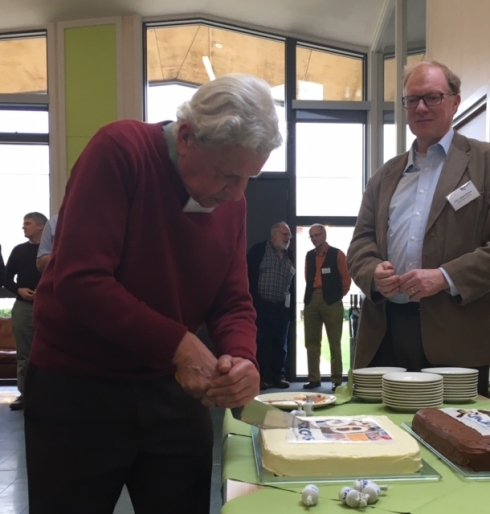- Home
- 50 years of the UK Cereal Pathogen Virulence Survey
50 years of the UK Cereal Pathogen Virulence Survey
Fifty years ago, in 1967, the coordinated monitoring of cereal pathogen populations in the UK began. To celebrate this golden anniversary, NIAB’s Dr Sarah Holdgate – UK Cereal Pathogen Virulence Survey (UKCPVS) project manager – reflected on major population changes and the implications these changes had on the industry at the 2017 UKCPVS Stakeholder Event
Before 1967
The surveillance of cereal pathogens stretches back many years before 1967. Although activity was fragmented, pathologists were acutely aware that populations never stood still and caused unexpected things to happen in crops.
1932, for example, saw yellow rust resistance break down in the wheat variety Vilmorin 23. In the same year, NIAB (which managed the recommended lists at that time) observed that Little Joss was ‘unusually resistant to yellow rust’ compared to many other varieties at that time.
The records from 1932, therefore, show the different ways varieties respond to the same pathogen pressure – from susceptible, to degrees of partial resistance, through to fully resistant.
By the 1950s, numerous institutes played a role in the monitoring of commercial crops (eg by NIAB) and plant breeding material (eg by PBI) but an unexpected turn of events was about to bring about a wave of collaboration that, thankfully, continues today.
1967 to 2017
The unforeseen event related to the wheat variety Rothwell Perdix. It carried a top yellow rust disease resistance rating of 9 into 1966 but left the list going into 1967 because of a ‘marked susceptibility’ to a new race of yellow rust.
The variety became a casualty of major gene resistance, which, unfortunately, can all too often be unpicked by new races. The event caught many off guard and demonstrated how much there was to learn about adult plant resistance.
The incident led to a series of meetings, in which agreement was made to organise and coordinate surveys of cereal pathogens. Through the meetings, it was also determined that breakdowns in major gene resistance needed to be monitored and that the underpinning genetic factors associated with breakdowns needed to be much better understood.
Funded by MAFF and the Agricultural Research Council, the early survey was called the ‘Physiologic Race Survey of Plant Pathogens’ and responsibility for coordinating the surveys fell to NIAB. The modern era of pathogen monitoring was born, which had early detection of new races at its heart.
In the 1960s, the survey looked at the key cereal plant pathogens at that time, covering:
- Wheat and barley yellow rust (NIAB)
- Wheat and barley powdery mildew (PBI)
- Oat powdery mildew and oat crown rust (WPBS)
- Rhynchosporium (Reading University)
- Oat leaf spot (Scottish Department of Agriculture)
One of the first new yellow rust races detected by the new coordinated network had a rather academic title – ‘104E137’.
Although the race rocketed in samples analysed by the monitoring network between 1969 and 1971, disease ratings remained unchanged for some time. In 1968, the wheat variety Joss Cambier had a disease rating of 6 but it wasn’t until 1972 that its rating was downgraded (to a 3).
This lag between detecting a change in the pathogen population and the eventual revision of disease ratings is often observed. It provides a clear example of how coordinated monitoring can bring about early warning to industry.
Another success of the coordinated approach was the introduction of a Diversification Scheme for yellow rust in 1976. The scheme grouped wheat varieties according to their susceptibility to yellow rust races. Such schemes help growers select varieties with a diverse mixture of resistance genes and spread risk across the farm.
The arrival of Warrior race in 2011, however, saw the system fail. The race, which came to dominate the UK population, was so diverse it meant that varieties all reacted in slightly different, and often unpredictable ways, meaning it was no longer possible to group varieties.
The UKCPVS continues to detect new races and assess the significance of these changes in the population – which includes a healthy dialogue with stakeholders involved in plant breeding and variety trials.
When yellow rust (YR) races were first detected in the UK
| Year | Variety | Key resistance gene combination |
| 1988 | Hornet | Yr6, Yr9 |
| 1994 | Brigadier | Yr9, Yr17 |
| 1996 | Madrigal | Yr6, Yr9, Yr17 |
| 2000 | Robigus | Yr4, Yr9, Yr17, Yr32 |
| 2008 | Solstice | Yr6, Yr9, Yr17, Yr32 |
| 2011 | Warrior | Yr6, Yr7, Yr9, Yr17, Yr32, Spaldings Prolific |
| 2014 | Kranich | Avirulence for Yr4, Yr8, Avirulence for Spaldings Prolific |
| 2015 | Invicta | Yr6, Yr9, Yr17, Yr32, Evolution |
The future
The importance of coordinated pathogen monitoring cannot be understated. And the future looks bright, especially when the emerging field of ‘pathogenomics’ is brought into the mix.
Led by the Earlham Institute’s Dr Diane Saunders, the complementary pathogenomics work exploits gene sequencing technology to analyse the same infected field samples as submitted to UKCPVS.
The process generates genotypic data which can be used to classify pathogen isolates into distinct genetic groups and track their movement across the globe. The technique can also be used enhance understanding of association between the pathogen and the host varieties infected by them.
At the 2017 event, it was also shown how pathogenomics can be used track pathogen populations through the season. Yellow rust Warrior groups, for example, do not rise and fall together – Warrior Group 4 isolates are found throughout the season, whereas Group 1 and Group 2 isolates tend to be detected in late spring and early summer.
Information on how pathogen genotypes fluctuate across the season could help explain what is seen in the field, and could also help provide new disease management solutions.
 NIAB
NIAB
 NIAB
NIAB
Photos of pathologists involved in the 1967 meetings
 AHDB
AHDB
Cereal pathogens monitored by the early survey: Oat crown rust, oat leaf spot, powdery mildew (wheat, barley and oat), rhynchosporium and yellow rust (wheat and barley)
 AHDB
AHDB
In 1967, Martin Wolfe (a pathologist at the former Plant Breeding Institute in Cambridge) helped kick start the modern pathogen monitoring movement. At the event, Martin cut a birthday cake to help celebrate the golden anniversary.

